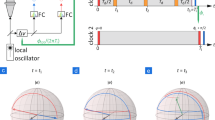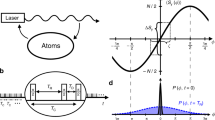Abstract
Optical atomic clocks require local oscillators with exceptional optical coherence owing to the challenge of performing spectroscopy on their ultranarrow-linewidth clock transitions. Advances in laser stabilization have thus enabled rapid progress in clock precision. A new class of ultrastable lasers based on cryogenic silicon reference cavities has recently demonstrated the longest optical coherence times to date. Here we utilize such a local oscillator with two strontium (Sr) optical lattice clocks to achieve an advance in clock stability. Through an anti-synchronous comparison, the fractional instability of both clocks is assessed to be \(4.8 \times 10^{ - 17}/\sqrt \tau\) for an averaging time τ (in seconds). Synchronous interrogation enables each clock to average at a rate of \(3.5 \times 10^{ - 17}/\sqrt \tau\), dominated by quantum projection noise, and reach an instability of 6.6 × 10−19 over an hour-long measurement. The ability to resolve sub-10−18-level frequency shifts in such short timescales will affect a wide range of applications for clocks in quantum sensing and fundamental physics.
This is a preview of subscription content, access via your institution
Access options
Access Nature and 54 other Nature Portfolio journals
Get Nature+, our best-value online-access subscription
$29.99 / 30 days
cancel any time
Subscribe to this journal
Receive 12 print issues and online access
$209.00 per year
only $17.42 per issue
Buy this article
- Purchase on Springer Link
- Instant access to full article PDF
Prices may be subject to local taxes which are calculated during checkout





Similar content being viewed by others
Data availability
The data that support the findings of this study are available from the corresponding authors upon reasonable request.
References
Bloom, B. J. et al. An optical lattice clock with accuracy and stability at the 10−18 level. Nature 506, 71–75 (2014).
Nicholson, T. L. et al. Systematic evaluation of an atomic clock at 2 × 10−18 total uncertainty. Nat. Commun. 6, 6896 (2015).
Huntemann, N., Sanner, C., Lipphardt, B., Tamm, C. & Peik, E. Single-ion atomic clock with 3 × 10−18 systematic uncertainty. Phys. Rev. Lett. 116, 063001 (2016).
McGrew, W. F. et al. Atomic clock performance enabling geodesy below the centimetre level. Nature 564, 87–90 (2018).
Brewer, S. M. et al. 27Al+ quantum-logic clock with a systematic uncertainty below 10−18. Phys. Rev. Lett. 123, 033201 (2019).
Takano, T. et al. Geopotential measurements with synchronously linked optical lattice clocks. Nat. Photon. 10, 662–666 (2016).
Riehle, F. Towards a redefinition of the second based on optical atomic clocks. C. R. Phys. 16, 506–515 (2015).
Huntemann, N. et al. Improved limit on a temporal variation of m p/m e from comparisons of Yb+ and Cs atomic clocks. Phys. Rev. Lett. 113, 210802 (2014).
Godun, R. M. et al. Frequency ratio of two optical clock transitions in 171Yb+ and constraints on the time variation of fundamental constants. Phys. Rev. Lett. 113, 210801 (2014).
Rosenband, T. et al. Frequency ratio of Al+ and Hg+ single-ion optical clocks; metrology at the 17th decimal place. Science 319, 1808–1812 (2008).
Chou, C. W., Hume, D. B., Rosenband, T. & Wineland, D. J. Optical clocks and relativity. Science 329, 1630–1633 (2010).
Grotti, J. et al. Geodesy and metrology with a transportable optical clock. Nat. Phys. 14, 437–441 (2018).
Sanner, C. et al. Optical clock comparison test of Lorentz symmetry. Nature 567, 204–208 (2019).
Delva, P. et al. Test of special relativity using a fiber network of optical clocks. Phys. Rev. Lett. 118, 221102 (2017).
Kolkowitz, S. et al. Gravitational wave detection with optical lattice atomic clocks. Phys. Rev. D 94, 124043 (2016).
Derevianko, A. & Pospelov, M. Hunting for topological dark matter with atomic clocks. Nat. Phys. 10, 933–936 (2014).
Arvanitaki, A., Huang, J. & Van Tilburg, K. Searching for dilaton dark matter with atomic clocks. Phys. Rev. D 91, 015015 (2015).
Itano, W. M. et al. Quantum projection noise: population fluctuations in two-level systems. Phys. Rev. A 47, 3554–3570 (1993).
Schioppo, M. et al. Ultra-stable optical clock with two cold-atom ensembles. Nat. Photon. 11, 48–52 (2017).
Nicholson, T. L. et al. Comparison of two independent Sr optical clocks with 1 × 10−17 stability at 103 s. Phys. Rev. Lett. 109, 230801 (2012).
Al-Masoudi, A., Dörscher, S., Häfner, S., Sterr, U. & Lisdat, C. Noise and instability of an optical lattice clock. Phys. Rev. A 92, 063814 (2015).
Campbell, S. L. et al. A Fermi-degenerate three-dimensional optical lattice clock. Science 358, 90–94 (2017).
Kolkowitz, S. et al. Spin–orbit-coupled fermions in an optical lattice clock. Nature 542, 66–70 (2017).
Zhang, X. et al. Spectroscopic observation of SU(N)-symmetric interactions in Sr orbital magnetism. Science 345, 1467–1473 (2014).
Martin, M. J. et al. A quantum many-body spin system in an optical lattice clock. Science 341, 632–636 (2013).
Bishof, M., Zhang, X., Martin, M. J. & Ye, J. Optical spectrum analyzer with quantum-limited noise floor. Phys. Rev. Lett. 111, 093604 (2013).
Häfner, S. et al. 8 × 10−17 fractional laser frequency instability with a long room-temperature cavity. Opt. Lett. 40, 2112–2115 (2015).
Kessler, T. et al. A sub-40-mHz-linewidth laser based on a silicon single-crystal optical cavity. Nat. Photon. 6, 687–692 (2012).
Matei, D. G. et al. 1.5 μm lasers with sub-10 mHz linewidth. Phys. Rev. Lett. 118, 263202 (2017).
Zhang, W. et al. Ultrastable silicon cavity in a continuously operating closed-cycle cryostat at 4 K. Phys. Rev. Lett. 119, 243601 (2017).
Robinson, J. M. et al. Crystaline optical cavity at 4 K with thermal noise limited instability and ultralow drift. Optica 6, 240–243 (2019).
Boyd, M. M. et al. Nuclear spin effects in optical lattice clocks. Phys. Rev. A 76, 022510 (2007).
Rubiola, E. & Vernotte, F. The cross-spectrum experimental method. Preprint at https://arxiv.org/abs/1003.0113 (2010).
Dick, J. G. Local oscillator induced instabilities in trapped ion frequency standards. In Proceedings of the 19th Annual Precise Time and Time Interval Meeting, 133–147 (US Naval Observatory, 1988); https://tycho.usno.navy.mil/ptti/1987papers/Vol%2019_13.pdf
Santarelli, G. et al. Frequency stability degradation of an oscillator slaved to a periodically interrogated atomic resonator. IEEE Trans. Ultrason. Ferroelectr. Freq. Control 45, 887 (1998).
Bothwell, T. et al. JILA Sr1 optical lattice clock with uncertainty of 2.0 × 10−18. Preprint at https://arxiv.org/abs/1906.06004 (2019).
Takamoto, M., Takano, T. & Katori, H. Frequency comparison of optical lattice clocks beyond the Dick limit. Nat. Photon. 5, 288–292 (2011).
Ushijima, I., Takamoto, M., Das, M., Ohkubo, T. & Katori, H. Cryogenic optical lattice clocks. Nat. Photon. 9, 185–189 (2015).
Riehle, F. Optical clock networks. Nat. Photon. 11, 25–31 (2017).
Cole, G. D., Zhang, W., Martin, M. J., Ye, J. & Aspelmeyer, M. Tenfold reduction of Brownian noise in high-reflectivity optical coatings. Nat. Photon. 7, 644–650 (2013).
Hutson, R. B., Goban, A., Marti, G. E. & Ye, J. Engineering quantum states of matter for atomic clocks in shallow optical lattices. Preprint at https://arxiv.org/abs/1903.02498 (2019).
Marti, G. E. et al. Imaging optical frequencies with 100 μHz precision and 1.1 μm resolution. Phys. Rev. Lett. 120, 103201 (2018).
Zhang, W. et al. Reduction of residual amplitude modulation to 1 × 10−6 for frequency modulation and laser stabilization. Opt. Lett. 39, 1980–1983 (2014).
Milner, W. R. et al. Demonstration of a time scale based on a stable optical carrier. Preprint at https://arxiv.org/abs/1907.03184 (2019).
Hänsel, W. et al. All polarization-maintaining fiber laser architecture for robust femtosecond pulse generation. Appl. Phys. B 123, 41 (2017).
Hänsel, W., Giunta, M., Fischer, M., Lezius, M. & Holzwarth, R. Rapid electro-optic control of the carrier-envelope-offset frequency for ultra-low noise frequency combs. In Proceedings of the Joint Conference of the European Frequency and Time Forum and IEEE International Frequency Control Symposium 128–129 (IEEE, 2017).
Giunta, M., Hänsel, W., Fischer, M., Lezius, M. & Holzwarth, R. Sub-mHz spectral purity transfer for next generation strontium optical atomic clocks. In Proceedings of the Conference on Lasers and Electro-Optics SM1L.5 (OSA, 2018).
Ma, L. S., Jungner, P., Ye, J. & Hall, J. L. Delivering the same optical frequency at two places: accurate cancellation of phase noise introduced by an optical fiber or other time-varying path. Opt. Lett. 19, 1777–1779 (1994).
Falke, S., Misera, M., Sterr, U. & Lisdat, C. Delivering pulsed and phase stable light to atoms of an optical clock. Appl. Phys. B 107, 301–311 (2012).
Howe, D. The total deviation approach to long-term characterization of frequency stability. IEEE Trans. Ultrason. Ferroelectr. Freq. Control 47, 1102–1110 (2000).
Acknowledgements
This work is supported by the National Institute of Standards and Technology (NIST), the Defense Advanced Research Projects Agency (DARPA), the Air Force Office of Scientific Research Multidisciplinary University Research Initiative, the National Science Foundation (NSF) JILA Physics Frontier Center (NSF PHY-1734006), the Cluster of Excellence (EXC 2132 Quantum Frontiers) and Physikalisch-Technische Bundesanstalt (PTB). E.O. and C.J.K. are supported by a postdoctoral fellowship from the National Research Council, L.S. is supported by a National Defense Science and Engineering Graduate Fellowship, A.G. is supported by a fellowship from the Japan Society for the Promotion of Science and C.S. is supported by a fellowship from the Humboldt Foundation. T.L., D.G.M. and U.S. acknowledge support from the Quantum sensors (Q-SENSE) project, supported by the European Commission’s H2020 Marie Skodowska-Curie Actions Research and Innovation Staff Exchange (MSCA RISE) under grant agreement no. 69115. M.G. and R.H. acknowledge support from the EU FP7 initial training network FACT (Future Atomic Clock Technology) and the DARPA Program in Ultrafast Laser Science and Engineering (PμreComb project) under contract no. W31P4Q-14-C-0050. The authors thank J. Munez and J. Sherman for careful reading of this manuscript.
Author information
Authors and Affiliations
Contributions
E.O., R.B.H., C.J.K., T.B., L.S., C.S., D.K., A.G., J.M.R., G.E.M. and J.Y. contributed to the clock instability measurements. E.O., J.M.R., L.S., C.J.K., T.B., D.K., D.G.M., T.L., F.R., U.S. and J.Y. worked on the Si cavity. L.S. and E.O. commissioned the laser stability transfer set-up based on the Er frequency comb developed by M.G. and R.H. All authors contributed to scientific discussions and the writing of this manuscript.
Corresponding authors
Ethics declarations
Competing interests
The authors declare no competing interests.
Additional information
Publisher’s note: Springer Nature remains neutral with regard to jurisdictional claims in published maps and institutional affiliations.
Supplementary information
Supplementary Information
Supplementary notes and figures.
Rights and permissions
About this article
Cite this article
Oelker, E., Hutson, R.B., Kennedy, C.J. et al. Demonstration of 4.8 × 10−17 stability at 1 s for two independent optical clocks. Nat. Photonics 13, 714–719 (2019). https://doi.org/10.1038/s41566-019-0493-4
Received:
Accepted:
Published:
Issue Date:
DOI: https://doi.org/10.1038/s41566-019-0493-4
This article is cited by
-
Direct comparison of two spin-squeezed optical clock ensembles at the 10−17 level
Nature Physics (2024)
-
Quantum-enhanced sensing on optical transitions through finite-range interactions
Nature (2023)
-
Widely tunable and narrow-linewidth chip-scale lasers from near-ultraviolet to near-infrared wavelengths
Nature Photonics (2023)
-
Realizing spin squeezing with Rydberg interactions in an optical clock
Nature (2023)
-
A lab-based test of the gravitational redshift with a miniature clock network
Nature Communications (2023)



